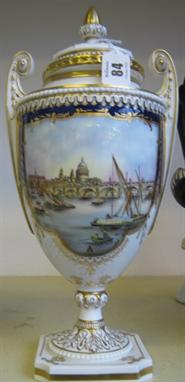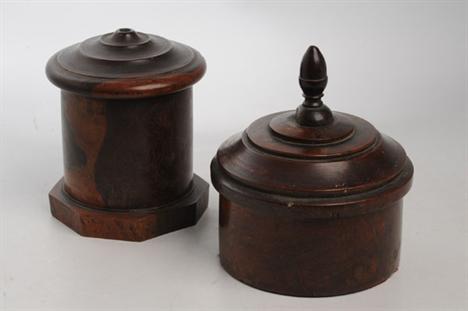We found 116061 price guide item(s) matching your search
There are 116061 lots that match your search criteria. Subscribe now to get instant access to the full price guide service.
Click here to subscribe- List
- Grid
-
116061 item(s)/page
Two similar mustard pots, of circular bulbous form with ball finial on domed hinged lid, scroll loop handle, blue glass liner, raised on three ball feet, 3 1/4" wide, Birmingham 1901 and 1915, with spoons, together with a pair of hexagonal salts with blue glass liners, Birmingham 1938, 7.06ozs (6)
A group of bone and ivory carvings, comprising: two figures of priests mounted on wood stands; a miniature table screen carved in relief with a warrior and scrip, wood stand; a Canton ivory pierced plaque, on wood stand; three netsuke depicting the Sambiki Saru (Three Wise Monkeys); two further figures; and a hardstone hat finial (af).
Mostly plated wares, comprising; a set of six pairs of fish knives and forks, cased, a pair of Eastern vases, a cake basket with a swing over handle, an egg cup stand, fitted with four egg cups, a bottle coaster, a twin handled sugar bowl, two trophy cups, a tea strainer, a circular dish, a pair of salts, a mustard pot, a pepperette, a twin handled salt and a bottle cork finial.
Silver, comprising; six pickle forks, with mother of pearl finials, (with one finial missing) London 1934, a sugar sifting spoon, Sheffield 1895, a pickle fork with a mother of pearl handle, two tablespoons, two teaspoons, a pair of salt spoons, Birmingham 1895 and two further silver condiment spoons.
A fine William IV brass inlaid goncalo alves bracket clock with centre seconds John Cross, Trowbridge, circa 1830 The five pillar twin fusee bell striking movement with deadbeat escapement and decorative border engraved backplate fixed into the case with conforming securing brackets, the 9 inch single sheet circular silvered brass Roman numeral dial signed Jn`o Crofs, TROWBRIDGE to centre and with Arabic fifteen minutes to outer track, the arched case with substantial brass pineapple finial and plinth applied to the shallow caddy upstand above contra-parti brass and ebony foliate marquetry arched border enclosing brass bezel with generous convex glass for the dial and recessed apron panel further decorated with heraldic design incorporating stags and foliate trails within bead moulded border, the sides veneered in decorative bands with brass ring handles above Gothic arch sound frets, on moulded base with brass ball feet, 61cm (2ft) high, with wall bracket decorated in premier-parti with foliate designs to frieze above brass inlaid scroll support with spade terminal, 88cm (2ft 11ins) high overall. THIS DESCRIPTION TO BE READ IN CONJUNCTION WITH ‘IMPORTANT NOTES REGARDING THE CATALOGUING OF CLOCKS’ PRINTED IN THE SALE CATALOGUE OR AVAILABLE FROM THE SALEROOM ON REQUEST. Provenance: Purchased by M.W. Allday Esq. of `The Shrubbery`, Hartlebury, Worcestershire from Peter Dryden Ltd. Antiques & Works of Art, Ferndown, Dorset, 11th March 1968, thence by descent to the current owner. John Cross is recorded in Loomes, Brian, Watchmakers & Clockmakers of the World Volume 2 as working in Trowbridge circa 1830. An apparently identical premier-parti version of the case housing the current lot is illustrated in Moore, A.J. THE CLOCKMAKERS OF BRISTOL 1650-1900 on page 299 enclosing a movement by Thomas Noble of Bath who worked 1829-50.
A George III miniature lantern alarm timepiece James Viall, Walsingham, circa 1760 The posted movement with verge escapement and alarm sounding on a bell mounted within the domed bearer above the frame with ball feet, column turned corner posts and vase finials flanking original foliate pierced frets to sides, the 5 inch brass break-arch dial with silvered alarm disc and matted centre within applied silvered Roman numeral chapter ring with short cruciform half hour markers and unusual female mask and scroll cast spandrels to angles, the arch with circular silvered boss signed Ja:s Viall, Walsingham flanked by mask and scroll cast mounts, the rear with hanging loop extension to the top plate and steel spikes screwed into the back feet 23cm (9ins) high overall. THIS DESCRIPTION TO BE READ IN CONJUNCTION WITH ‘IMPORTANT NOTES REGARDING THE CATALOGUING OF CLOCKS’ PRINTED IN THE SALE CATALOGUE OR AVAILABLE FROM THE SALEROOM ON REQUEST. James Viall is recorded in Loomes, Brian Watchmakers & Clockmakers of the World Volume 2 as working in Walsingham circa 1760. This clock with exception of the side doors, finial and bell appears to have survived in remarkably original condition.
A fine George I brass mounted ebonised quarter chiming table clock of impressive proportions Simon DeCharmes, London circa 1720 The substantial ten pillar triple fusee movement (plates measuring 10 by 9 inches) chiming the quarters on eight bells and striking the hours on a further bell, the backplate profusely engraved with Ho-Ho bird inhabited foliage, the 10 inch brass break-arch dial with calendar and false bob aperture signed S. De Charmes, London within applied silvered Roman numeral chapter ring with fleur-de-lys half hour markers and Arabic five minutes to outer track, the angles with female mask and scroll cast spandrels beneath regulation dial calibrated 0-60 flanked by dolphin mounts to arch, the case with brass ball-and-spire finials to the brass edged inverted bell top above carrying handles and brass edged break-arch windows to sides, the front with conforming brass surround to dial aperture and upper quadrants, on moulded base with brass ogee bracket feet, 69cm (2ft 3ins) high excluding top finial. THIS DESCRIPTION TO BE READ IN CONJUNCTION WITH ‘IMPORTANT NOTES REGARDING THE CATALOGUING OF CLOCKS’ PRINTED IN THE SALE CATALOGUE OR AVAILABLE FROM THE SALEROOM ON REQUEST. Simon DeCharmes was a French Huguenot immigrant clockmaker who became a Free Brother of the Clockmakers Company in 1691. His work can be directly compared with that of his contemporary Claude DuChesne with both makers being particularly well known for producing highly decorative clocks usually playing music or with other complications such as long duration. There are at least two clocks known where DuChesne has supplied the movement to DeCharmes including a fine walnut three month duration quarter-repeating longcase clock which was sold in these rooms on the 9th September 2009 (lot 102). Simon DeCharmes is known to have been working in London up to around 1730 when it thought that he may have returned to France. The current lot demonstrates DeCharmes no expense spared approach to clockmaking, the massive movement with no less than ten pillars was clearly made with the intention to fill what is in essence an oversized case. The form of the case with its applied brass mouldings (particularly the aperture surrounds to doors and side windows) are typical of those used to house movements by DeCharmes during the latter years of his career in London. Other oversized table clocks are known, particularly from the Windmills Workshop (a walnut clock of large proportions was sold in these rooms 21st March 2007 lot 403), another example by George Graham with a rectangular dial was formerly in the Iden collection. It is probable that such clocks were either made simply to impress or to be utilised in a semi-public context where the use of a longcase clock would be problematic.
A Fine George III small gilt brass mounted ebonised quarter chiming table clock John Coleman, London, circa 1780 The six-pillar triple fusee movement chiming the quarters on eight bells and striking the hour on a further bell, with verge escapement and winding squares to the foliate engraved backplate signed John Coleman, London, the 4.25 inch circular convex white enamel Roman numeral dial with Arabic five minutes and finely pierced and chased gilt brass hands, the case with cast swag adorned flambeau vase finial to the concave sided pediment inset with foliate engraved brass fret panels and applied with husk swags, above cavetto cornice applied with rocaille cast finials and animal mask-and-swag frieze above further foliate scroll engraved fret infill around dial flanked by applied fluted Ionic pilasters, the sides with arched sound frets and conforming pilasters, on stepped base with brass ogee moulding and squat bun feet, 44cm (17.5ins) high. THIS DESCRIPTION TO BE READ IN CONJUNCTION WITH ‘IMPORTANT NOTES REGARDING THE CATALOGUING OF CLOCKS’ PRINTED IN THE SALE CATALOGUE OR AVAILABLE FROM THE SALEROOM ON REQUEST. Provenance: The property of Viscount Portman, Spencer House thence by descent to The Late Henry Clive and Mrs. Clive, formerly of Perrystone Court, Herefordshire. John Coleman is recorded in Baillie, G.H. Watchmakers & Clockmakers of the World as working from Tottenham Court Road, London 1781-4. He specialised in highly decorative musical and chiming clocks mainly for export to China. Please Note: that whilst on view , a detachable section to top of case has come apart at the joints. This should not present much of a problem for a reasonably competent case restorer.
A rectangular piece of oak commemorating the launch of HMS Victory in 1765, engraved on one side `Victory 1765` and `S.P. Knight` on reverse, in white metal pendant frame, 1 1/4in wide and an ivory Crochet Hook with hand finial, together with an ivory Book Mark, 5 1/2in also with hand finial (3)
A Victorian silver teapot, by Robert Harper, London 1868, of compressed circular form with a waisted neck and moulded girdle on shell capped scroll bracket supports, with a leaf capped scroll handle and melon finial to the domed cover, and a similar cream jug and two handled sugar bowl, by John Wright, Newcastle 1839, gilt interiors, all crested, 38oz (3) Visit www.sworder.co.uk for larger image and condition reports.
A George III silver tea caddy, maker`s mark overstruck, T?, London, 1779, of oval form, the hinged cover with leaf and bud finial, bright cut engraved with floral swags and wrigglework borders, with vacant oval cartouches, 10.5cm high 13oz Visit www.sworder.co.uk for larger image and condition reports.
A Victorian matching small silver coffee pot on stand, by James Garrard, the coffee pot London 1882, the stand London 1885, stamped Garrards Panton Street London, the coffee pot of tapering cylindrical form with a wicker handle, the domed cover with ball finial, the circular stand with burner below resting on three scroll feet, 20cm high overall 14oz (3) Visit www.sworder.co.uk for larger image and condition reports.
An 18th century mahogany eight-day longcase clock, the 12" brass dial with an arched top, strike silent, date and calendar rings and four seasons spandrels, now in a mahogany case with inlaid `fan` decoration and quarter fluted columns. 209cm high (to top of finial) Visit www.sworder.co.uk for larger image and condition reports.
A good late 18th century mahogany stick barometer by George Adams, Fleet Street, London, the architectural cresting centred by a brass urn finial over a waisted feather banded trunk with a moulded edge and exposed tube, terminating in a turned hemispherical cistern cover. The one piece silver dial signed in an arch `George Adams, 60 Fleet Street, London, Instrument Maker to His Majesty`. 102cm high. George Adams was one of the most eminent instrument makers of the 18th century, holding the appointment of `Mathematical Instrument-Maker to the Prince of Wales`, i.e. George III before 1760, and later, of course, the King. He was father of George Adams, The Younger, and Dudley Adams. George Adams Senior and Junior both worked at the same address and enjoyed the royal patent, it is therefore difficult in many cases to assign authorship with confidence. Visit www.sworder.co.uk for larger image and condition reports.
-
116061 item(s)/page






























